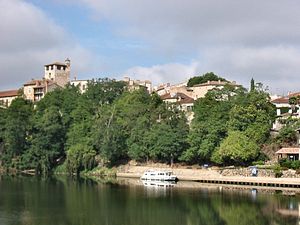Clairac
| Clairac | ||
|---|---|---|

|
|
|
| region | Nouvelle-Aquitaine | |
| Department | Lot-et-Garonne | |
| Arrondissement | Marmande | |
| Canton | Tonneins | |
| Community association | Val de Garonne agglomeration | |
| Coordinates | 44 ° 22 ' N , 0 ° 23' E | |
| height | 27-185 m | |
| surface | 33.78 km 2 | |
| Residents | 2,622 (January 1, 2017) | |
| Population density | 78 inhabitants / km 2 | |
| Post Code | 47320 | |
| INSEE code | 47065 | |
| Website | http://www.clairac.com | |
 Clairac with mooring in the foreground |
||
Clairac is a municipality with 2,622 inhabitants (at January 1, 2017) in France in the department of Lot-et-Garonne in the region Nouvelle-Aquitaine .
geography
Clairac is located on the lower reaches of the Lot River , about ten kilometers above the confluence with the Garonne . The bridge over the Lot was opened in 1939 after the suspension bridge from 1831 was no longer able to cope with traffic.
history
- The village developed around an abbey that was founded in 767 by Pippin "the Kurzen" .
- Already in the 13th century the abbey was settled by 150 monks, the abbot was responsible for five priories and 50 parishes. After the vicissitudes of the Hundred Years War there were only nine monks left, but the abbey quickly filled with monks again and monastic life continued.
- In 1556 the monk André Thevet brought back tobacco seeds from a trip to Brazil, which were planted in the abbey gardens (five years before Jean Nicot ). Another monk brought back saplings of plums from a trip to the Middle East , the further cultivation of which is known today as the “Plum of Agen ” (French: Prune d'Ente ).
- Clairac was a center of ecclesiastical reform and a fortress of Protestantism in this area. In 1534 the Abbot of Clairac received John Calvin with his idea of “restoring the church to its original purity”. The poet Théophile de Viau (1590–1626), Huguenot by birth but a free spirit of faith, was born in Clairac.
- Since the city constantly undermined the central secular and spiritual power of the state through its liberal ideas, Louis XIII sat down . personally at the head of his army, besieged Clairac and captured it in 1621 .
- In the 17th century Clairac was an important and prosperous city with excellent scientists:
- Jacques de Romas (1713–1776), built the first lightning rod at Vivens Castle in 1753 (before Benjamin Franklin ).
- François Labat de Vivens (1697–1780), physicist and agricultural scientist, is the neighbor and friend of
- Montesquieu , who wrote the “ Persian Letters ” in Barry's castle and sketched his work “On the Spirit of Laws”.
- The French Revolution hit Clairac at a time when the city was enjoying a thriving economy. Well located at the entrance to the Lot Valley, Clairac exported wine, tobacco, plums and all the other agricultural products of the region. The negative consequences of the revolution led to the decline of the city, compounded by the subsequent decline in agriculture, the industrial revolution , rural exodus and many other socio-economic changes.
- A policy of reactivating the village made it possible to establish Clairac as a small town, but one that is increasingly popular with tourists. In recent years this trend has been reinforced by the promotion of water tourism on the Lot with sports boats and houseboats .
Sons and daughters of the church
- Théophile de Viau (1590–1626), French poet and dramaturge
Web links
Commons : Clairac (Lot-et-Garonne) - Collection of images, videos and audio files
- Official website of the city (French)
